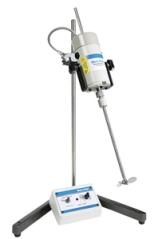Laboratory Equipment: A Guide to Mixer Selection
When choosing laboratory equipment such as a mixer, several variables should be considered specific to your application. For mixers, gather the follow information:

Stir-Pak High-speed, Low-Torque Mixer System (23-2300rpm, 115 VAC)
- What container capacity do you need?
- What liquid viscosity?
- What are your torque requirements?
- What are your horsepower requirements?
- What rotational speed or RPM do you need? What diameter for the mixing propeller?
- What are your requirements for duty cycle?
- What will be the source of your power supply?
Laboratory Mixers are available with permanent magnet, universal, or air-drive motors. Choose different mixer mounts for mounting on tanks or stands. A variety of impellers and paddles lend versatility to the mixer you select.
Industrial Mixers are available with electric- or air-driven motors for up to 1-hp. Fixed- or variable-speed and direct- or gear-driven options are available.
Specialty Mixers include:
Sanitary Mixers for all applications requiring extra clean processes.
Bulk-Container Mixers mount atop tote containers and mix liquids that are in long- or short-term storage.
Handheld Mixers for mixing thin or heavy liquids in open or closed containers.
Static Mixers are installed inline and mix fluids as you pump them through a pipeline. The fluid moves through the mixer in an alternating clockwise/counterclockwise motion to ensure a homogeneous product. They are virtually maintenance free and need no spare parts.

Comentarios
Publicar un comentario